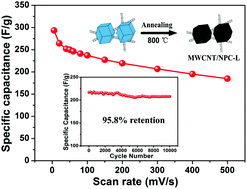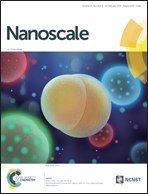Supercapacitor electrode materials with hierarchically structured pores from carbonization of MWCNTs and ZIF-8 composites†
Abstract
Due to their high specific surface area and good electric conductivity, nitrogen-doped porous carbons (NPCs) and carbon nanotubes (CNTs) have attracted much attention for electrochemical energy storage applications. In the present work, we firstly prepared MWCNT/ZIF-8 composites by decoration of zeolitic imidazolate frameworks (ZIF-8) onto the surface of multi-walled CNTs (MWCNTs), then obtained MWCNT/NPCs by the direct carbonization of MWCNT/ZIF-8. By controlling the reaction conditions, MWCNT/ZIF-8 with three different particle sizes were synthesized. The effect of NPCs size on capacitance performance has been evaluated in detail. The MWCNT/NPC with large-sized NPC (MWCNT/NPC-L) displayed the highest specific capacitance of 293.4 F g−1 at the scan rate of 5 mV s−1 and only lost 4.2% of capacitance after 10 000 cyclic voltammetry cycles, which was attributed to the hierarchically structured pores, N-doping and high electrical conductivity. The studies of symmetric two-electrode supercapacitor cells also confirmed MWCNT/NPC-L as efficient electrode materials that have good electrochemical performance, especially for high-rate applications.

- This article is part of the themed collections: Top articles from NCNST and 2017 Nanoscale HOT Article Collection


 Please wait while we load your content...
Please wait while we load your content...